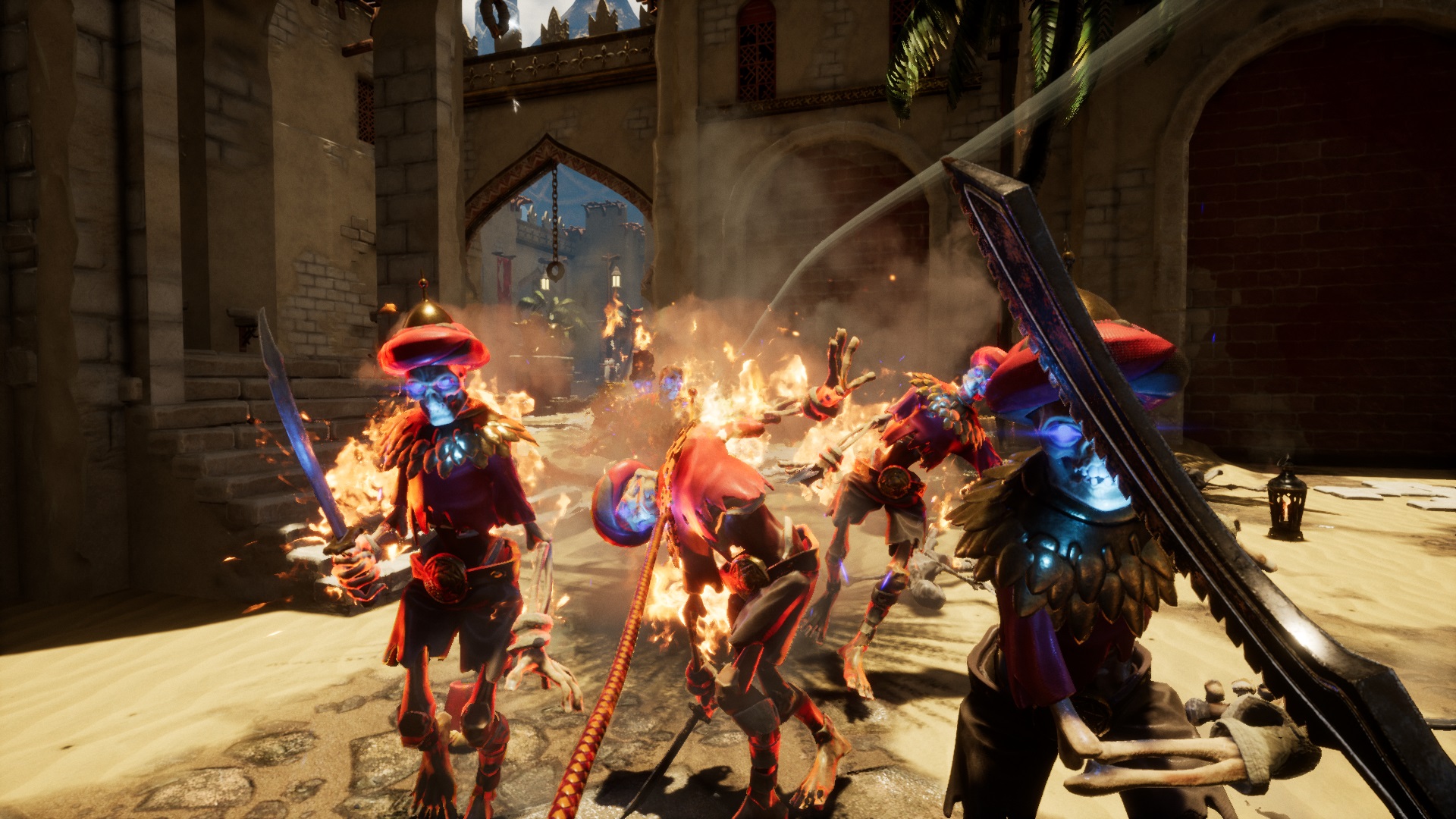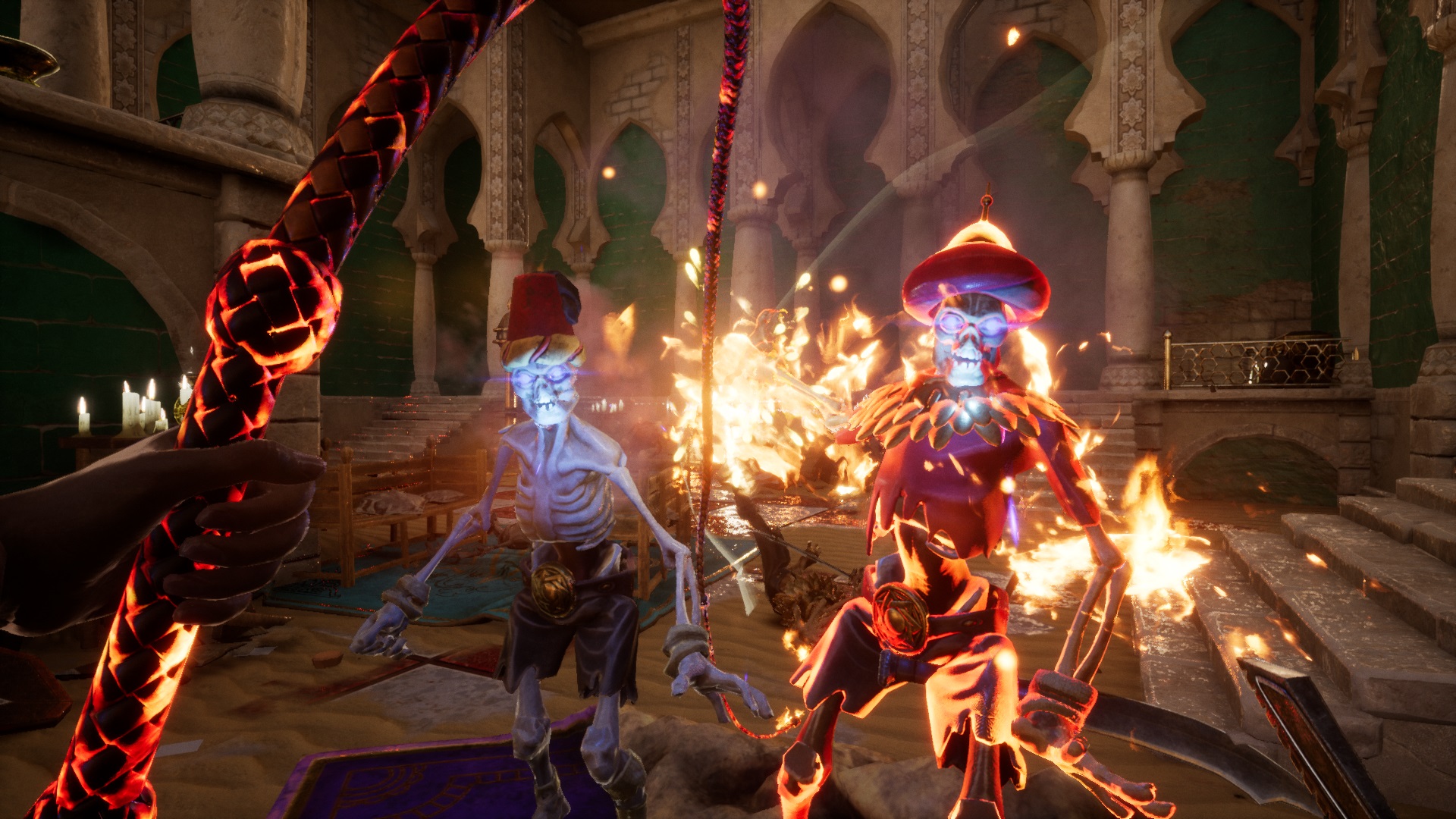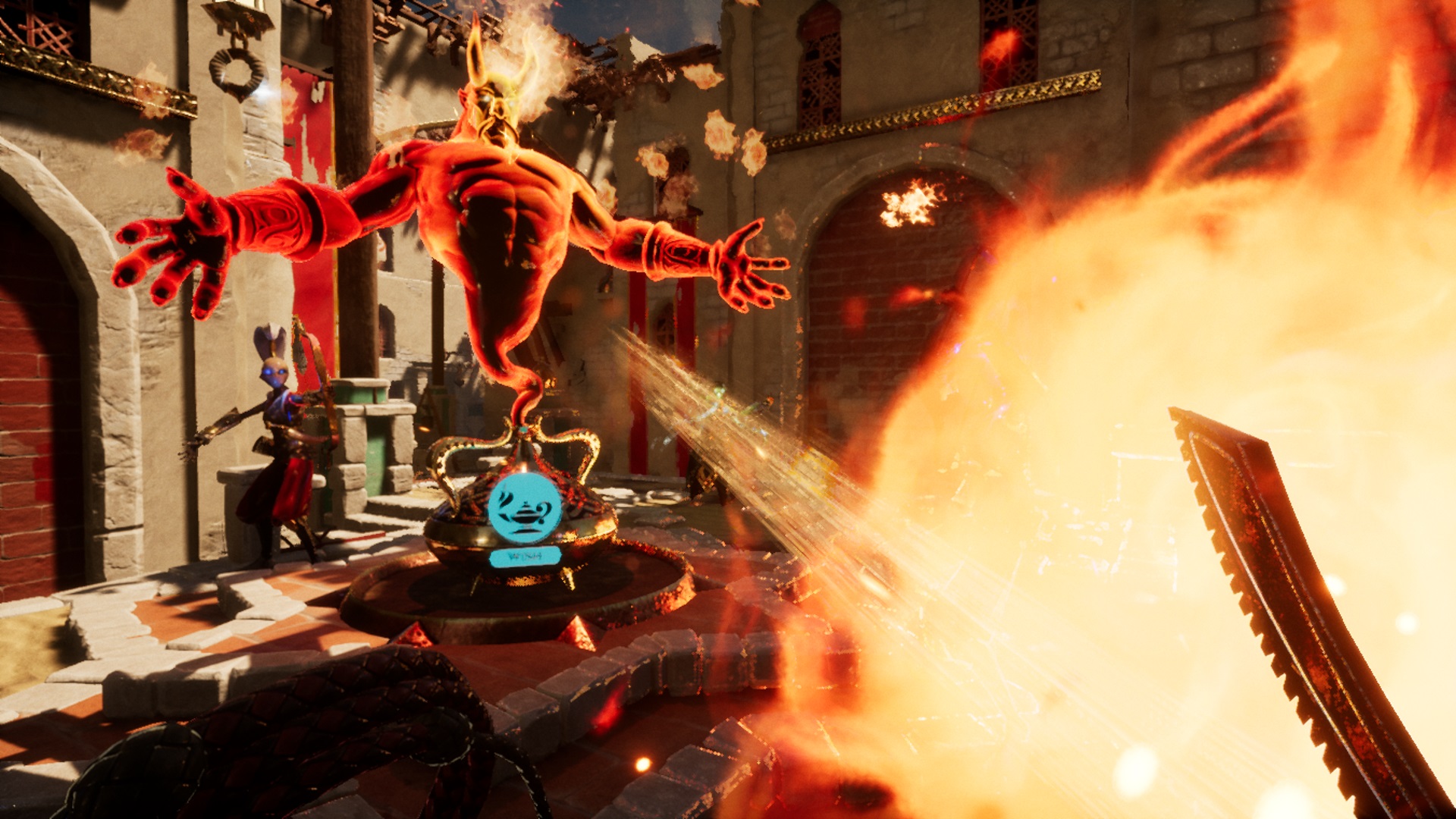Platforms:
Xbox One, PS4, PC
Released:
May 5, 2018
Publisher:
Uppercut Games
Developer:
Uppercut Games
Set in a gorgeous Arabian Nights inspired world, City of Brass is a whip-cracking roguelike that has recently released onto PS4, Xbox One, and PC. Made by developers who had formerly worked on the Bioshock series, the game and its eye-catching aesthetic immediately stood out when we played it at PAX AUS 2017. Bubbling away on Steam Early Access since September of last year, the game has finally emerged as a full product.
Made by Uppercut Games based out of Australia, City of Brass had me excited. The game is a first-person melee experience themed around Arabian myth akin to franchises such as Indiana Jones or Prince of Persia. With your curved scimitar and whip in hand, you move throughout a procedurally generated world, fighting skeletons, haggling with Djinn, and side-stepping deadly traps. The game is a roguelike, meaning the world around you is always randomly created and once you die, you start fresh from the beginning.
The game’s aesthetic and theming really is captivating. It’s quite impressive visually and the Arabian Nights theme simply isn’t explored enough in gaming and popular culture as a whole. There is a lot of rich myth that exists within this universe and to see it represented is always a big win. City of Brass handled that representation well for the most part, although there is certainly room to expand further and dive deeper into that lore.
The game has a shine and a polish to its visuals. It’s honestly what made me so eager to jump in and experience the game to begin with. Unfortunately that polish isn’t translated perfectly into the gameplay. First-person melee combat is a difficult thing to perfect and City of Brass reminded me exactly why. Judging depth of field for every swing simply isn’t enjoyable, match that with some hit detection problems and a lack of elegant player movement and you have some seriously awkward encounters at the best of times. The smartest thing City of Brass does is encourage its players to use environmental effects to deal with their foes so as to avoid sword combat all together. Explosive objects are scattered around the world which you can whip to detonate, you can also pick up and throw objects, and utilise traps to dispose of your enemies for you. These interactions feel a lot better, although they are band-aid solutions to a problem that never needed to exist to begin with. I simply don’t know why City of Brass is first-person game, it doesn’t seem to benefit from that perspective at all.

Your whip tends to be your best friend in the game. Whipping enemies stuns them and allows you to dispose of them much easier. You can also whip treasure and objects toward yourself, detonate explosives, use your whip to set off traps, and even use it for some platforming to launch yourself into the air.
Similarly to sword combat though you will occasionally run into hit detection problems using the whip which is unfortunate. For the most part though your whip is a trustworthy companion that adds diversity and depth to combat encounters.
I find the game’s movement as stiff as the game’s melee combat. City of Brass adds some diversity to its movement with the ability to jump and pull yourself up onto ledges, there are also specific spots you can whip to launch yourself forward. Outside of this it is just a lot of shambling around. The game doesn’t offer me a level of control or finesse to pull off the kind of moves I want. Aligning itself thematically with franchises such as Prince of Persia and Indiana Jones is probably part of its undoing in this sense because in my mind I am jumping from wall to wall and leaping away from rolling boulders at the last second, but in reality I am awkwardly side-stepping foes and flailing my whip around.
“I never felt like I was competing against my own abilities, but instead competing against awkward design.”
The game’s less than perfect movement and combat is a particularly big issue for me because it is a roguelike. In roguelike games you are experiencing the core gameplay loop over and over again. If that loop isn’t captivating then you’re stuck in a repetitive and unengaging cycle.
It reached a point where I wasn’t even motivated to complete the game because I never felt like I was competing against my own abilities, but instead competing against awkward design.
As you play you find treasure which you can spend at one of the game’s various Djinns. The Djinns will offer different upgrades, new equipment, and special abilities that range from disabling all traps in your area to summoning an NPC to help you in battle. There’s quite a lot of variety to the items and abilities you can unlock which is fantastic because each attempt feels just that little bit different depending on what you choose. Old favourites will begin to stand out though so experiment with everything at least once to find what suits you best, but try to always keep enough money spare to spend on health upgrades.
Treasure is a commonality within the game although exploring thoroughly will usually allow you to uncover a lot more. It can be fun to hunt around although the game also has a severe time penalty if you take too long to progress to the next area. The time limit is on by default although it can be turned off (thankfully). Unfortunately the vast majority of my time with the game was played whilst the time penalty was mandatory and it drove me mad. It stopped me from doing any of that fun exploration and certain set pieces throughout the game, such as small platforming areas, I begun to completely ignore due to time pressure.
Playing the game with the time pressure disabled brought about its own problems. All of a sudden you realise that the safest and smartest way to play the game is super cautiously, attacking from a distance and avoiding frenetic enemy encounters. I begun to realise how formulaic the optimum play style was and got bored.
Progressing further into the game you will begin to unlock new areas, see new enemies and encounter different bosses. The progression of the game feels good. Its not too difficult, nor is it too easy and a full playthrough may take around 2 hours (depending on your speed). The variety was certainly there although no enemy or location ever stood out as particularly amazing or exciting. The random generation of the map was decent but not phenomenal. I certainly came across structurally similar sections each time I played because I don’t think there was ever a huge amount of variation to that random generation formula.
Positive:
- Spectacular visuals
- Awesome and under-utilised theme
- Creative whip functionality
Negative:
- Awkward and stiff combat
- Movement during combat left a lot to be desired
- An imperfectly implemented time-limit mechanic damages player enjoyment
City of Brass certainly isn’t a terrible game although it’s one I won’t be particularly eager to return to. The game just didn’t feel that well thought out from an overall player enjoyment and gameplay perspective. With so many roguelikes on the market I would struggle to recommend this one to anybody outside of a very specific demographic. The development team clearly has talent although they way not have been working to their strengths.















